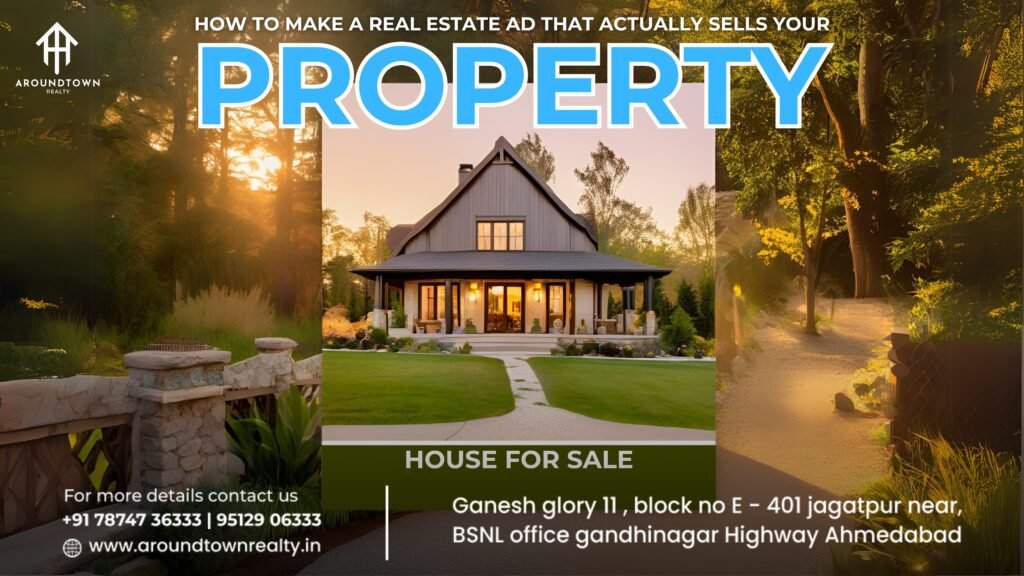Selling a property in today’s competitive market requires more than just listing it online. You need a compelling real estate ad that grabs attention, engages potential buyers, and ultimately leads to a sale. In this guide, we’ll take you through a step-by-step process on how to make a real estate ad that sells your property faster and at the best price.
1. Understanding the Importance of a Well-Crafted Real Estate Ad
A well-written real estate ad isn’t just a description—it’s a powerful marketing tool. Your ad should do more than provide basic property details; it should evoke emotions, create urgency, and inspire action. With the right wording and structure, you can make your listing stand out from thousands of others online.
Why Does a Good Real Estate Ad Matter?
- First Impressions Count – Buyers often decide within seconds whether they want to learn more about a property.
- Higher Engagement – A well-structured ad can generate more inquiries and showings.
- Faster Sales – An effective ad attracts serious buyers and reduces the time your property stays on the market.
- Better Offers – Highlighting key features well can justify your asking price and even lead to competitive offers.
2. The Essential Elements of a High-Converting Real Estate Ad
Key Elements of an Effective Real Estate Ad
- Compelling Headline: The headline is the first thing potential buyers will see. It should be attention-grabbing and convey the most appealing aspect of the property. For example, “Charming 3-Bedroom Home with Spacious Backyard in Downtown Delhi.”
- High-Quality Photos and Videos: Visuals are crucial in real estate advertising. High-resolution photos and well-produced videos can showcase the property’s features and create an emotional connection with buyers. Consider hiring a professional photographer or videographer to capture the property in the best light.
- Detailed Property Description: Provide a comprehensive description that highlights the property’s key features, such as the number of bedrooms and bathrooms, square footage, unique architectural elements, recent renovations, and nearby amenities. Use descriptive language to help buyers visualize themselves in the space.
- Clear Call to Action (CTA): Encourage potential buyers to take the next step, whether it’s scheduling a viewing, contacting the agent, or visiting an open house. A clear CTA can guide buyers through the process and increase the likelihood of a sale.
- Accurate Contact Information: Ensure that your contact information is easy to find and accurate. Include multiple ways for potential buyers to reach you, such as phone, email, and social media profiles.
Crafting a Compelling Headline
The headline of your real estate ad is your first chance to make an impression. It should be concise yet descriptive, highlighting the property’s most attractive features. Consider the following tips when crafting your headline:
- Highlight Unique Features: If the property has a distinctive feature, such as a rooftop terrace, a swimming pool, or a historic design, mention it in the headline.
- Include the Location: Location is a significant factor for buyers. Including the neighborhood or city can attract buyers interested in that area.
- Use Descriptive Adjectives: Words like “luxurious,” “spacious,” “cozy,” or “modern” can evoke positive feelings and attract attention.
Examples of Effective Headlines:
- “Modern 2-Bedroom Apartment with Panoramic City Views in South Delhi”
- “Elegant Victorian Home with Lush Garden in Prestigious Gurgaon Neighborhood”
- “Eco-Friendly Family Home with Solar Panels and Organic Garden in Noida”
READ THIS FOR MORE, The Power of Real Estate Taglines: How to Make Your Brand Stand Out
The Power of High-Quality Visuals
In the digital age, visuals play a crucial role in real estate advertising. High-quality photos and videos can make your property stand out and provide potential buyers with a virtual tour of the space.
Tips for Effective Real Estate Photography:
- Use Natural Light: Shoot photos during the day when natural light is abundant. Open curtains and blinds to let in as much light as possible.
- Stage the Property: Ensure the property is clean and well-staged. Remove personal items and clutter to create a neutral space that buyers can envision as their own.
- Capture Key Areas: Focus on essential areas like the kitchen, living room, master bedroom, and any unique features such as a home office or outdoor space.
- Use a Tripod: A tripod can help stabilize the camera and produce sharper images.
Incorporating Video Tours:
Video tours can provide a more immersive experience for potential buyers. They allow buyers to get a feel for the property’s layout and flow. Consider creating a virtual walkthrough or a narrated tour highlighting the property’s features.
Crafting a Detailed Property Description
A well-written property description can complement your visuals and provide potential buyers with the information they need to consider your property seriously.
Structure of an Effective Property Description:
- Introduction: Start with a brief overview of the property’s most appealing features.
- Property Details: Provide specifics such as the number of bedrooms and bathrooms, square footage, lot size, and any recent upgrades or renovations.
- Unique Features: Highlight any unique aspects of the property, such as a gourmet kitchen, spa-like bathroom, or energy-efficient systems.
- Location Highlights: Mention nearby amenities like schools, parks, shopping centers, and public transportation.
- Call to Action: Encourage potential buyers to take the next step, such as scheduling a viewing or contacting the agent for more information.
Example: “Discover your dream home in the heart of Bangalore! This beautifully designed 3BHK apartment boasts a spacious living room, a modern modular kitchen, and a private balcony with stunning city views. Located in a gated community with top-tier amenities, including a swimming pool, gym, and children’s play area, this home is perfect for families. Just minutes away from top schools, shopping malls, and metro stations. Don’t miss out—schedule your viewing today!”
High-Quality Images and Videos
Visuals are the most critical aspect of a real estate ad. High-resolution images and professional video tours can significantly boost interest.
Tips for Real Estate Photography:
- Use natural lighting for a bright and welcoming feel
- Capture the best angles of each room
- Highlight unique features like a fireplace, backyard, or balcony
- Declutter and stage the property for a clean, inviting look
Why Include Video Tours?
- Allows buyers to get a virtual walkthrough
- Provides an immersive experience
- Can be shared easily on social media to reach a larger audience
Highlighting Key Selling Points
Buyers want to know what makes your property stand out. Use bullet points to make key features easy to scan.
Example List of Selling Points:
- Newly renovated kitchen with quartz countertops
- Spacious master suite with walk-in closet
- Private backyard with a landscaped garden
- Located in a secure gated community
- Walking distance to metro and shopping centers
Adding a Strong Call to Action (CTA)
Your ad should guide potential buyers on the next steps. Examples of strong CTAs include:
- “Schedule a viewing today! Call [Your Contact Number]”
- “Click here to book a tour!”
- “Contact us now before this amazing home is sold!”
3. Where to Advertise Your Real Estate Listing for Maximum Exposure
Once you have crafted the perfect real estate ad, it’s time to share it where potential buyers are most likely to see it.
Best Platforms for Real Estate Advertising:
- Property Portals – 99acres, MagicBricks, Housing.com, and NoBroker
- Social Media – Facebook Marketplace, Instagram, LinkedIn, and WhatsApp groups
- Google Ads – Invest in paid ads for better visibility
- Local Newspapers & Magazines – Still effective for reaching certain demographics
CHECK THIS OUT, Top Real Estate Ads That Convert: Strategies for More Leads & Sales
4. Common Mistakes to Avoid When Writing a Real Estate Ad
Even a small mistake can make your ad less effective. Here are some common pitfalls to avoid:
- Using Generic Descriptions – Instead of saying “beautiful home,” describe what makes it beautiful.
- Lack of High-Quality Images – Poor visuals can turn off potential buyers instantly.
- Overpricing – If your price is too high compared to market rates, buyers will move on.
- No Contact Information – Always provide clear and multiple ways to get in touch.
- Weak Call to Action – Tell buyers exactly what they need to do next.
5. Conclusion – Get Expert Help with Selling Your Property
Writing a compelling real estate ad takes skill, time, and marketing expertise. If you want to ensure maximum exposure and attract the right buyers, VISIT US at Around Town Realty can help!
Contact us today to get started!
FAQs
- What is the best way to write a real estate ad? A great real estate ad should have a compelling headline, high-quality images, a detailed property description, and a strong call to action.
- How can I make my real estate ad stand out? Use engaging language, highlight unique features, include professional photos, and market your listing on multiple platforms.
- Should I hire a professional photographer for my real estate ad? Yes! High-quality images significantly increase buyer interest and make your property look more appealing.
- Where should I advertise my real estate listing? Use property portals like 99acres and MagicBricks, social media platforms, and even local newspapers for maximum exposure.
- Can a real estate agent help improve my property listing? Absolutely! Real estate agents have experience in crafting ads that attract serious buyers and close deals quickly.










